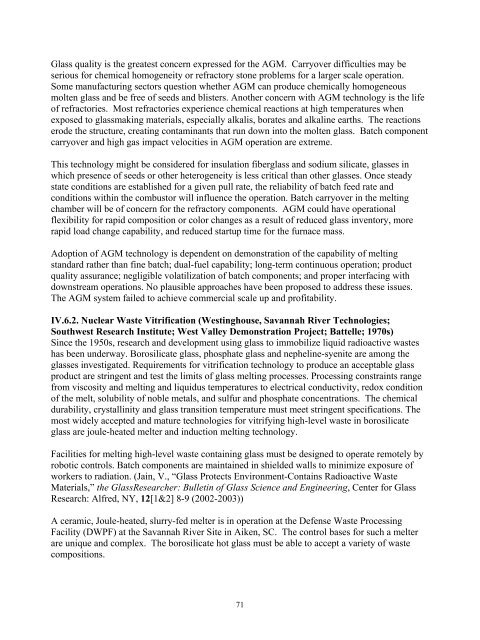Glass Melting Technology: A Technical and Economic ... - OSTI
Glass Melting Technology: A Technical and Economic ... - OSTI
Glass Melting Technology: A Technical and Economic ... - OSTI
You also want an ePaper? Increase the reach of your titles
YUMPU automatically turns print PDFs into web optimized ePapers that Google loves.
<strong>Glass</strong> quality is the greatest concern expressed for the AGM. Carryover difficulties may be<br />
serious for chemical homogeneity or refractory stone problems for a larger scale operation.<br />
Some manufacturing sectors question whether AGM can produce chemically homogeneous<br />
molten glass <strong>and</strong> be free of seeds <strong>and</strong> blisters. Another concern with AGM technology is the life<br />
of refractories. Most refractories experience chemical reactions at high temperatures when<br />
exposed to glassmaking materials, especially alkalis, borates <strong>and</strong> alkaline earths. The reactions<br />
erode the structure, creating contaminants that run down into the molten glass. Batch component<br />
carryover <strong>and</strong> high gas impact velocities in AGM operation are extreme.<br />
This technology might be considered for insulation fiberglass <strong>and</strong> sodium silicate, glasses in<br />
which presence of seeds or other heterogeneity is less critical than other glasses. Once steady<br />
state conditions are established for a given pull rate, the reliability of batch feed rate <strong>and</strong><br />
conditions within the combustor will influence the operation. Batch carryover in the melting<br />
chamber will be of concern for the refractory components. AGM could have operational<br />
flexibility for rapid composition or color changes as a result of reduced glass inventory, more<br />
rapid load change capability, <strong>and</strong> reduced startup time for the furnace mass.<br />
Adoption of AGM technology is dependent on demonstration of the capability of melting<br />
st<strong>and</strong>ard rather than fine batch; dual-fuel capability; long-term continuous operation; product<br />
quality assurance; negligible volatilization of batch components; <strong>and</strong> proper interfacing with<br />
downstream operations. No plausible approaches have been proposed to address these issues.<br />
The AGM system failed to achieve commercial scale up <strong>and</strong> profitability.<br />
IV.6.2. Nuclear Waste Vitrification (Westinghouse, Savannah River Technologies;<br />
Southwest Research Institute; West Valley Demonstration Project; Battelle; 1970s)<br />
Since the 1950s, research <strong>and</strong> development using glass to immobilize liquid radioactive wastes<br />
has been underway. Borosilicate glass, phosphate glass <strong>and</strong> nepheline-syenite are among the<br />
glasses investigated. Requirements for vitrification technology to produce an acceptable glass<br />
product are stringent <strong>and</strong> test the limits of glass melting processes. Processing constraints range<br />
from viscosity <strong>and</strong> melting <strong>and</strong> liquidus temperatures to electrical conductivity, redox condition<br />
of the melt, solubility of noble metals, <strong>and</strong> sulfur <strong>and</strong> phosphate concentrations. The chemical<br />
durability, crystallinity <strong>and</strong> glass transition temperature must meet stringent specifications. The<br />
most widely accepted <strong>and</strong> mature technologies for vitrifying high-level waste in borosilicate<br />
glass are joule-heated melter <strong>and</strong> induction melting technology.<br />
Facilities for melting high-level waste containing glass must be designed to operate remotely by<br />
robotic controls. Batch components are maintained in shielded walls to minimize exposure of<br />
workers to radiation. (Jain, V., “<strong>Glass</strong> Protects Environment-Contains Radioactive Waste<br />
Materials,” the <strong>Glass</strong>Researcher: Bulletin of <strong>Glass</strong> Science <strong>and</strong> Engineering, Center for <strong>Glass</strong><br />
Research: Alfred, NY, 12[1&2] 8-9 (2002-2003))<br />
A ceramic, Joule-heated, slurry-fed melter is in operation at the Defense Waste Processing<br />
Facility (DWPF) at the Savannah River Site in Aiken, SC. The control bases for such a melter<br />
are unique <strong>and</strong> complex. The borosilicate hot glass must be able to accept a variety of waste<br />
compositions.<br />
71

















